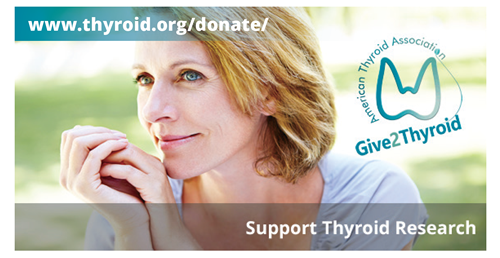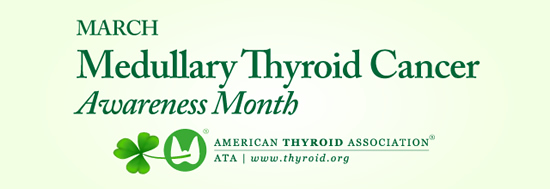Clinical Thyroidology for the Public summarizes selected research studies discussed in the previous month’s issue of Clinical Thyroidology, an official publication of the American Thyroid Association. Editor-in-chief, Alan Farwell, MD, FACE
Volume 11 Issue 3
Available in pdf format for saving and printing and Web page format for viewing online
PDF Format for Saving and Printing
Clinical Thyroidology for the Public Volume 11 Issue 3 (PDF file, 6.04 MB)
TABLE OF CONTENTS – Web Format
HYPOTHYROIDISM IN CHILDREN U.S. newborn screening of congenital hypothyroidism
In the United States, thyroid blood tests are done 1-3 days after birth at the hospital as part of a national newborn screening program to detect congenital hypothyroidism. Each state determines which blood tests to perform and sets their own cutoffs for determining when the result should be interpreted as abnormal. This paper examines the differences in thyroid screening programs in newborns.
Kilberg MJ et al 2018 Newborn Screening in the U.S. May Miss Mild Persistent Hypothyroidism. J Pediatr 192:204-8.
(PDF File for saving and printing, 817 KB)
THYROID FUNCTION TESTS Significant variations of thyroid testing in the US argue for improved standardization of practice patterns
There are many different tests available to evaluate the function of the thyroid gland. However, many tests are over utilized and/or may not be appropriate for the type of thyroid problem suspected. The objectives of this study were to compare patterns of thyroid testing ordered between different institutions, to assess the appropriateness of such testing, and to evaluate whether laboratory utilization protocols showed improvements in thyroid testing.
Lin DC et al and the Thyroid Benchmarking Group. Multicenter Benchmark Study Reveals Significant Variation in Thyroid Testing in the United States. Thyroid 2017;27:1232-45.
(PDF File for saving and printing, 646 KB)
THYROID DISEASE AND PREGNANCY Thyroid antibodies in the mother are associated with cardiac and metabolic risk factors in the children at age 16
There has been recent interest on how factors in the mother during pregnancy may affect their children later in life. Thyroid problems are common in women and the association between the thyroid status of the mother during pregnancy and her child’s health later in life has not been well studied. This study set up to study whether there is an association between thyroid autoimmunity and the child’s risk to develop the cardiometabolic syndrome in later life.
Heikkinen AL et al. Maternal thyroid antibodies associates with cardiometabolic risk factors in children at the age of 16. J Clin Endocrinol Metab. September 11, 2017 [Epub ahead of print].
(PDF File for saving and printing, 607 KB)
THYROID NODULES Validation of American Thyroid Association ultrasound risk assessment of thyroid nodules selected for biopsy
Thyroid nodules are very common. Although the majority of these nodules are non-cancerous, a small proportion do contain thyroid cancer. A thyroid ultrasound is an accurate test that can determine nodule characteristics and help physicians decide which nodules should be evaluated with a thyroid biopsy. The aim of this study was to evaluate the ultrasound appearance of thyroid nodules and correlate this with cytology and pathology results in order to validate the ultrasound risk-pattern categories proposed by the recent American Thyroid Association guidelines.
Tang, AL et al. Validation of American Thyroid Association Ultrasound Risk Assessment of Thyroid Nodules Selected for Ultrasound Fine-Needle Aspiration. Thyroid 2017;27:1077-82.
(PDF File for saving and printing, 726 KB)
THYROID CANCER FDG-PET-positive thyroid incidentalomas
In 1–2% of PET scans performed for the diagnosis or staging of non-thyroid cancers, incidental uptake of a thyroid lesion is detected. Current American Thyroid Association guidelines recommends biopsy of all PET-positive nodules >1cm that are not definitively benign on a diagnostic thyroid ultrasound. However, there has not been a large study looking at the prognosis of these thyroid cancers that are identified incidentally on PET imaging.
Pattison DA et al. 18F-fluorodeoxyglycose-avid thyroid incidentalomas: the importance of contextual interpretation. J Nucl Med 2017;Oct 12:pii: jnumed.117.198085 [Epub ahead of print].
(PDF File for saving and printing, 641 KB)
THYROID CANCER A second radioactive iodine treatment alone is of little benefit in treating patients with thyroid cancer that has spread into the lymph nodes in the neck
Up to 30% of patients treated with total thyroidectomy and radioactive iodine therapy have persistent metastatic thyroid cancer in the lymph nodes in the neck. Repeated doses of radioactive iodine therapy has proven to be beneficial in patients with thyroid cancer that has spread outside of the neck. This study was intended to determine whether a second radioactive iodine therapy in patients with thyroid cancer in the lymph nodes in the neck is beneficial.
Hirsch D et al. Second radioiodine treatment: limited benefit for differentiated thyroid cancer with locoregional persistent disease. J Clin Endocrinol Metab. November 3, 2017.
(PDF File for saving and printing, 605 KB)
ATA ALLIANCE FOR THYROID PATIENT EDUCATION





